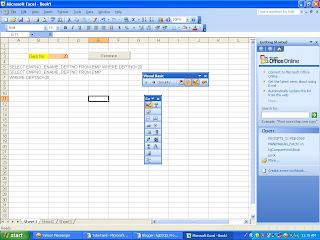Other Web Resources for EXCEL - VBA Programming.When I started developing macros for the first time using
LOTUS 123 during 1992-93, I could not get help from any professional. I had to rely with 123.hlp file, which was not available with all LOTUS 123 installation. In our Computer Centre only one PC has HARD DISK, all other PCs are booted from floppy only!!! Internet is available in big cities only. So by sitting late night, I learned LOTUS 123 macro and played around. Mostly to amaze my friends and colleagues.
First macro was put into use in the Ageing Report developed by me in
QuatroPro Spreadsheet. That time also I relied with QuatroPro help file. During 1995 situation is somewhat better as most of the PCs had Hard disk.
During Late 90's When I told my colleagues that ACCESS table can be better presented in EXCEL, they believed me. But they thought that I am talking about EXPORT command in ACCESS. When I reiterated them it can be directly fetched from a command button in EXCEL and summarize the sales data. They thought that I was crazy!!! But When I showed my first application they became crazy!!!
Sorry for the long history. But It might give you some idea that information is power in these IT Age. So here is a partial list of popular websites which will give you better tips, tricks and techniques (than me!!!) for EXCEL-VBA .
http://www.excel-vba.com/This is one of the most visited website by EXCEL-VBA programmers. It has very good introduction. You may know VBA means Visual Basic for Application. But VBA-EXCEL, VBA-ACCESS, VBA-WORD, VBA-OUTLOOK are explained in this website very simply. You please visit this website. If you prefer you can purchase the lessons.
http://www.anthony-vba.kefra.com/This page is popularly known as Anthony's Excel VBA (Macro) Tutorial. It has many scientific, mathematical and business algorithms implemented in EXCEL-VBA functions, procedues and workbooks. Good starting point for any aspiring EXCEL-VBA Developer. The basic tutorial section is one the excellent work.
http://xl.barasch.com/I like this website very much. It has many examples, which are relevant to most of the situation. Whenever I require a routine, first I will try in this website. It has many useful and strange functions of great useful. Must visit website for all EXCEL-VBA developers.
http://www.mindspring.com/~tflynn/excelvba.htmlIt is a great website for collection of useful utilities in EXCEL-VBA. Frequenty I refer this website and learn a technique and apply for my solution. It has good link to other excel resources.
http://www.ozgrid.com/One of the useful and free webresource for VBA programmers. It has sample VBA code, which can be effectively customized for our requirements. The combo box for FAQ is having a list of useful FAQ which makes navigation very simple.
http://www.angelfire.com/biz7/julian_s/julian/julians_macros.htmThis has many simple yet useful tricks and techniques
http://www.functionx.com/vbaexcel/This website I visited recently and found it is organised for self learning and the content is really valuable and lucid. The lesson summary will give us option to start reading relevant content.
Last but not the least
http://kgexcel.blogspot.com/
It is designed my me!!!
and there is official website from Microsoft, which is the only comprehensive help resource for EXCEL-VBA programming.
Cheers! Enjoy EXCEL-VBA Programming
Here is my assurance of prompt reply to your queries. My email id karthiganesh@yahoo.com.

 Once again I reiterate that I will send this excel file free of charges, if you send me an email.
Once again I reiterate that I will send this excel file free of charges, if you send me an email.

